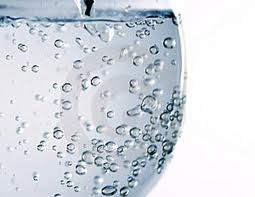 There are several reasons why your water heater needs to be strapped to the wall framing. These are commonly called earthquake straps, and they are a code requirement for specific zones.
There are several reasons why your water heater needs to be strapped to the wall framing. These are commonly called earthquake straps, and they are a code requirement for specific zones.
So one reason for the straps is to preserve the health and safety of the home’s occupants. Not only could seismic movement cause the water heater to fall onto someone or something, but it could also rupture the gas line and/or water supply.
Another not so obvious reason is to give people a supply of potable water in case of a crisis. What kind of crisis? Imagine an earthquake strikes and ruptures utilities. Not only could a ruptured gas line cause fires, but a ruptured water line could stop water supplies to people’s homes. The only source of clean drinkable water may just be in your water heater. True, the water will be hot, but at least it is safe. If water service is stopped to your house during a crisis, at least you could have the water volume in the water heater tank to use…either 40, 50, or 75 gallons to use until service gets restored.
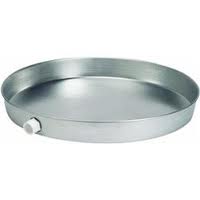 Installing a drain pan underneath your water heater is a good idea. You typically don’t just decide to install one, rather when your water heater gets replaced, it’s a good idea to add a pan if you don’t already have one.
Installing a drain pan underneath your water heater is a good idea. You typically don’t just decide to install one, rather when your water heater gets replaced, it’s a good idea to add a pan if you don’t already have one.
The water heater pan has a hole in the side wall so that you can run a drain line from the pan. It does no good to install a pan and not run a drain line from it. It simply postpones the eventual leak by about 2 minutes.
When you buy the pan, the drain fitting for the sidewall should be included. This is a threaded fitting with a washer on the inside of the pan and is secured by a fitting on the outside of the pan. From there the drain is run.
Typically, the drain is run to the floor and it is gravity-fed. On the bottom of the drain line you can install an elbow to direct the water away from the water heater stand.
When the water heater leaks, it will drip into the pan. When the water in the pan rises high enough to enter the drain fitting, it will finally run down the drain line and out. Naturally, if you see water in the pan or on the floor, you have a problem.
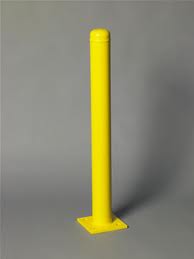 For many people who have their water heater in the garage, you likely have a bollard protecting it from your car. A bollard is a steel pole attached to the slab and its job is to sacrifice itself to protect the water heater.
For many people who have their water heater in the garage, you likely have a bollard protecting it from your car. A bollard is a steel pole attached to the slab and its job is to sacrifice itself to protect the water heater.
There are times when the bollard will get bumped with the car. It usually won’t get damaged because it is filled with concrete. It will however get scraped up and for that you can just paint the pole. If you want to get fancy, you can install a bollard cover to dress it up.
Bollard covers are basically plastic sleeves that fit over the pole. They come in a variety of colors and can have a rounded or square top. You can also buy them with an architectural styling, which would include ridges and textures other than just a flat surface.
These install fairly quickly. The surface should be clean and free of dirt and oils. They come with adhesive strips that you wrap around the pole in several different locations. There is a lip and the strip that is angled downward. This allows you to push the bollard cover over the bollard, but it makes it difficult to remove.
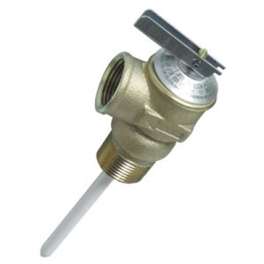 A water heater has a TPR (temperature and pressure relief) valve for safety. This allows the tank to vent excess pressure and heat and is a measure to prevent the tank from exploding. Manufacturers recommend testing the valve periodically by toggling the handle on the valve. The only problem is, sometimes the TPR doesn’t stop dripping after toggling the handle.
A water heater has a TPR (temperature and pressure relief) valve for safety. This allows the tank to vent excess pressure and heat and is a measure to prevent the tank from exploding. Manufacturers recommend testing the valve periodically by toggling the handle on the valve. The only problem is, sometimes the TPR doesn’t stop dripping after toggling the handle.
You can try a quick fix but it may not work and you may be faced with replacing the valve. Try using a hammer and giving the end of the valve a light “tap”. The tapping may just reseat the valve and your job is done. If the valve still leaks, you are looking at replacing the valve.
It isn’t a difficult job, but you should shut the water off to the water heater and drain it down to just below the level of the valve. The valve may be located at the top or side of the tank. Disconnect the drain line from the valve and then use a wrench to unscrew the valve from the tank.
Wrap the threads of the new valve with Teflon tape and install it back into the tank. Reconnect the drain line and turn the water back on.
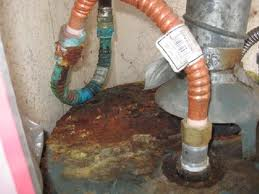 The only reason you would want to remove water heater nipples is if they are leaking or so badly corroded that they look like they will start to leak. They really aren’t something you would choose to do normal maintenance on. However, be careful how much you chew off here…sometimes it is as if the water heater nipples are welded into the tank.
The only reason you would want to remove water heater nipples is if they are leaking or so badly corroded that they look like they will start to leak. They really aren’t something you would choose to do normal maintenance on. However, be careful how much you chew off here…sometimes it is as if the water heater nipples are welded into the tank.
After you remove the supply lines at the top of the nipples, try some penetrating oil around the threads (where they enter the tank) and wait. The oil may or may not help, but the answer lies in leverage. Use the biggest pipe wrench you can find and place the jaws around the unthreaded surface at the midpoint of the nipple. Then try to unscrew the nipple. Then try some more. With any luck, you will hear a “snap” sound, and the nipple will start to unscrew. You don’t want to hear that sound and have the nipple shear off. It’s a gamble, but there really isn’t a foolproof method to removing these. If the nipple does shear off, your day just got longer. Here is some information on how to remove a sheared off water heater nipple.
Use dielectric nipples to replace the old nipples. They won’t corrode like the old ones did.
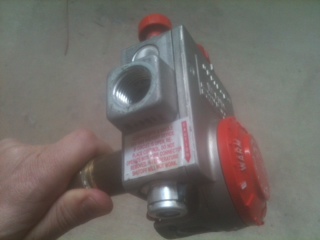 Replacing a water heater gas control valve is a big deal. Once you’ve gotten to this point, you have to ask yourself if you should be considering replacing the entire water heater. The control valve is expensive and if your water heater is getting old anyway, it may be time to bite the bullet.
Replacing a water heater gas control valve is a big deal. Once you’ve gotten to this point, you have to ask yourself if you should be considering replacing the entire water heater. The control valve is expensive and if your water heater is getting old anyway, it may be time to bite the bullet.
Turn the gas off so that the handle is perpendicular to the pipe and remove the gas line from the control valve. Also turn the water off to the water heater at the top of the tank and then connect a hose to the hose connection at the bottom of the tank. Open the hose valve and start draining the tank. Be careful as this will be very hot water (assuming the water heater has been on and heating water).
There are three connections remaining at the bottom of the control valve: the main gas line, the pilot tube, and the thermocouple. Remove these connections from the valve. The control valve will be ready to spin out. Use a large pipe wrench and place it over the top of the valve. Unscrew the valve from the tank…this probably won’t be easy. You will have to go to a plumbing supply store, so take the old valve with you to make sure you get the correct part.
Reinstalling the new valve is a matter of reversing the order when removing it. Wrap the threads of the new valve and tighten it up by hand, then give it an extra turn with the wrench. Connect the main gas tube first, then the pilot tube and thermocouple. Reconnect the gas line from the wall, refill the tank and light the pilot. You should have hot water in about an hour. By the way, for a sealed burner unit, in addition to the above, there are wires that go into the burner chamber and you must have an exact replacement.
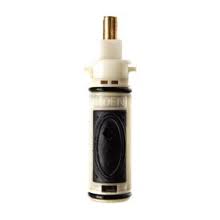 Low hot water pressure can be confusing to some people. People immediately think the water heater is to blame, but that isn’t always the case. If you have hot water, the problem isn’t the water heater. Incoming water pressure pushes water into the water heater and then out to your fixtures. The problem is more likely with your fixture or a valve somewhere.
Low hot water pressure can be confusing to some people. People immediately think the water heater is to blame, but that isn’t always the case. If you have hot water, the problem isn’t the water heater. Incoming water pressure pushes water into the water heater and then out to your fixtures. The problem is more likely with your fixture or a valve somewhere.
The big question is, do you have low water pressure in the entire house or just one fixture? The key is to isolate the problem. If the problem is just at one fixture, then concentrate on that one fixture. If you have low pressure in the entire house, check the supply valve that controls the incoming cold water into the water heater (since cold water throughout the house is not a problem, you can exclude issues dealing with cold water). If that valve is a gate valve, I would focus on that. Gate valves can corrode and the gate can shear off and either partially or completely block the water from passing. This could be the issue if you have low hot water pressure throughout the entire house (or none at all).
If the problem is in a shower, and the valve has a single handle that controls both hot and cold, I would probably replace the cartridge in the valve. This is a common issue, especially with Moen posi-temp shower valves. Replacing the cartridge will fix the problem.
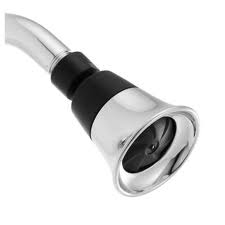 With the holiday season comes water heater stress. You get guests in your house and when everyone wants to shower, the water heater works overtime.
With the holiday season comes water heater stress. You get guests in your house and when everyone wants to shower, the water heater works overtime.
Sure, you could stagger showers with enough time in between for the water heater to catch up and reheat enough water for the next person. Here is a stupid, simple idea that works: use less hot water. Now, I’m not demanding short submariner type showers (although that would work). Nor am I saying you should turn the water off as you are soaping up (yes that would place less stress on your water heater too). I’m suggesting you replace your showerheads.
If you have 2.5 gallon per minute showerheads now, and you replace them with 1.6 gallon heads, you will save nearly 1 gallon of water for every minute you shower. So if you have guests staying at your house you can rack up the savings, and let the water heater breathe a little easier. Let’s assume you have 4 people at the house and each takes a 10 minute shower (probably a conservative estimate). Do the math: 4 people x 10 minutes = 40 minutes of total shower time. Take 40 minutes x .9 gallons (2.5 gallons minus 1.6 gallons) of water savings per minute =36 gallons of water per day that they stay over. Best of all, it will only take you 5 minutes to replace a shower head.
 You see water leaking from the top of your water heater and you start to panic. You have every right to panic, although it may not be as bad as you think.
You see water leaking from the top of your water heater and you start to panic. You have every right to panic, although it may not be as bad as you think.
If the water is a yellow-rust color, I would worry. It likely means long term corrosion has damaged your water heater tank or a fitting on the tank. If the water is clear, you still may have damage at your tank or on a fitting, but follow the water.
Although the water may be pooling on the top of the water heater, it may be ending up there from somewhere else…like on your water supply line. See if the lines that connect to the nipples are wet. If they are, the leak is somewhere above the tank, likely at the copper flex line, a fitting, or the incoming supply valve. Touch the pipe with a piece of toilet paper. If it is leaking, the toilet paper will pick up the wetness. If either of the pipes above the water heater are wet, you will need to determine what is leaking and replace it.
If the pipes are dry, the best you can hope for is that one of the nipples are leaking at the top of the heater. The best case scenario is that you end up replacing a nipple or the rubber washer in between the nipple and the water supply line. The worst case scenario is that you are replacing the water heater.
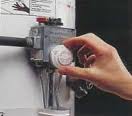 New tenants moved into a house and were talking about how the water heater didn’t produce enough hot water. They said that the hot water stopped after only 10 minutes or so. There could me many factors here, so it was best to look at the water heater.
New tenants moved into a house and were talking about how the water heater didn’t produce enough hot water. They said that the hot water stopped after only 10 minutes or so. There could me many factors here, so it was best to look at the water heater.
The water heater was only a few months old and was professionally installed. The chances that a dip tube was broken or other part was already bad were slim. If the dip tube was broken, then incoming cold water wouldn’t be pushed to the burner to warm it up and you get lukewarm water after it mixes with the hot water already in the tank….but that wasn’t the problem. I looked for a large bathtub that maybe used all the hot water. Nope, they take showers. Then I considered the most obvious…the setting on the thermostat. It was set on its lowest setting. Duh!
I set the thermostat on the next setting up from the lowest and the burner fired up, just like it was supposed to. Once the water heater started heating the water to a higher temperature, the tenant used less of the available hot water and the problem was solved. I try to set the thermostat at the lowest possible setting to get the necessary amount of hot water, but no more. There is no need to waste energy.